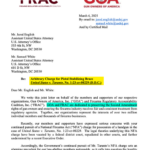
CZ Scorpion Case: A Legal Precedent for Pistol Brace Ownership
Tháng 4 13, 2025How Tariffs Are Transforming the Tech Landscape: The Hidden Costs of Smartphones, Computers, and Chips
Tháng 4 13, 2025The Ongoing Impact of Tariffs on Technology Products: A Closer Look
The complex landscape of global trade has recently seen a noteworthy phenomenon – the continuation of a 20% tariff on essential technology goods, such as smartphones, computers, and semiconductors. As this situation evolves, it is crucial to understand the implications these tariffs have on various stakeholders, including consumers, manufacturers, and the broader economy.
Background on the Tariff Continuation
The U.S. government’s decision to uphold these tariffs is not merely a standalone action; rather, it is reflective of enduring trade tensions that characterize relationships between major global economies. Tariffs, fundamentally, are utilized as strategic tools in trade disputes, employed to protect domestic industries and retain leverage in negotiations. These tariffs are particularly significant for technology products, which are at the heart of modern economic infrastructure.
The Ripple Effects on Consumers and Manufacturers
The ramifications of these tariffs extend far beyond political discourse. Both consumers and manufacturers experience direct impacts as a result of the elevated costs associated with these levies. For manufacturers, absorbing the cost increase is often untenable, leading them to pass on expenses to the end consumer. This translates into higher prices on smartphones, computers, and various tech components – a situation that can inhibit consumer demand and suppress profitability for companies attempting to remain competitive in a challenging market.
The increased costs stemming from tariffs further complicate the already intricate web of the global supply chain. Major technology firms rely heavily on international suppliers for essential components, like semiconductors. As tariffs disrupt the flow of goods, sourcing strategies must be reassessed, resulting in operational uncertainties and potential delays for tech companies.
Recent Developments in Trade Negotiations
Despite ongoing negotiations among some of the world’s largest economies, there has been little progress in significantly reducing these tariffs on technology products. This stagnation suggests a strategic use of tariffs, serving not only as a form of economic protectionism but also as leverage in broader diplomatic dialogues. Stakeholders within the technology sector have voiced concerns regarding the long-term implications of a tariff-laden environment, advocating for more open markets that could foster economic growth and stimulate innovation. Notably, China’s President Xi Jinping has been actively engaging top global CEOs to discuss such trade tensions, demonstrating the broader implications and strategic intentions at play in maintaining global economic stability amidst these challenges. For more on this topic, visit this blog.
The Industry’s Response and Wider Economic Implications
In response to these trade obstacles, tech companies and industry associations are actively lobbying for a reevaluation of existing tariffs. Their advocacy reflects a collective understanding that a more open trade environment could enhance opportunities for economic advancement, innovation, and consumer choice.
Moreover, the implications of tariffs reach far and wide, influenced by myriad factors such as inflation rates and job markets. Financial analysts and policymakers remain vigilant, monitoring these developments, as the effects of tariffs will invariably vary among different industries and nations.
For those interested in diving deeper into the ramifications of these trade policies and the economic landscape shaped by them, sources such as Bloomberg, Forbes, and CNBC provide extensive coverage of ongoing trade trends and economic analysis.
As the global trade environment remains in flux, it is clear that the continuation of tariffs on technology products reflects broader geopolitical strategies. Understanding these dynamics is essential for navigating the complexities of the modern economy.
